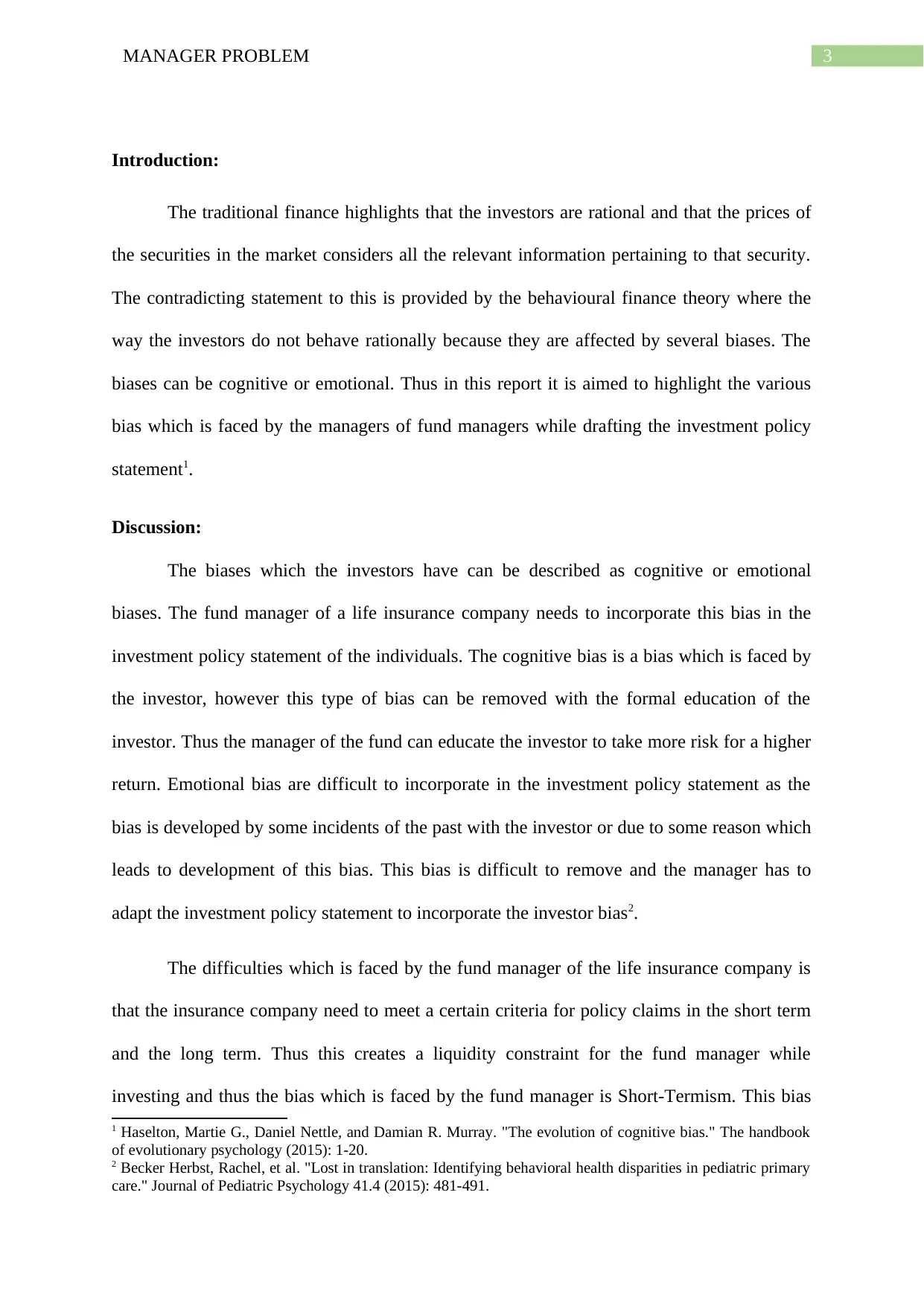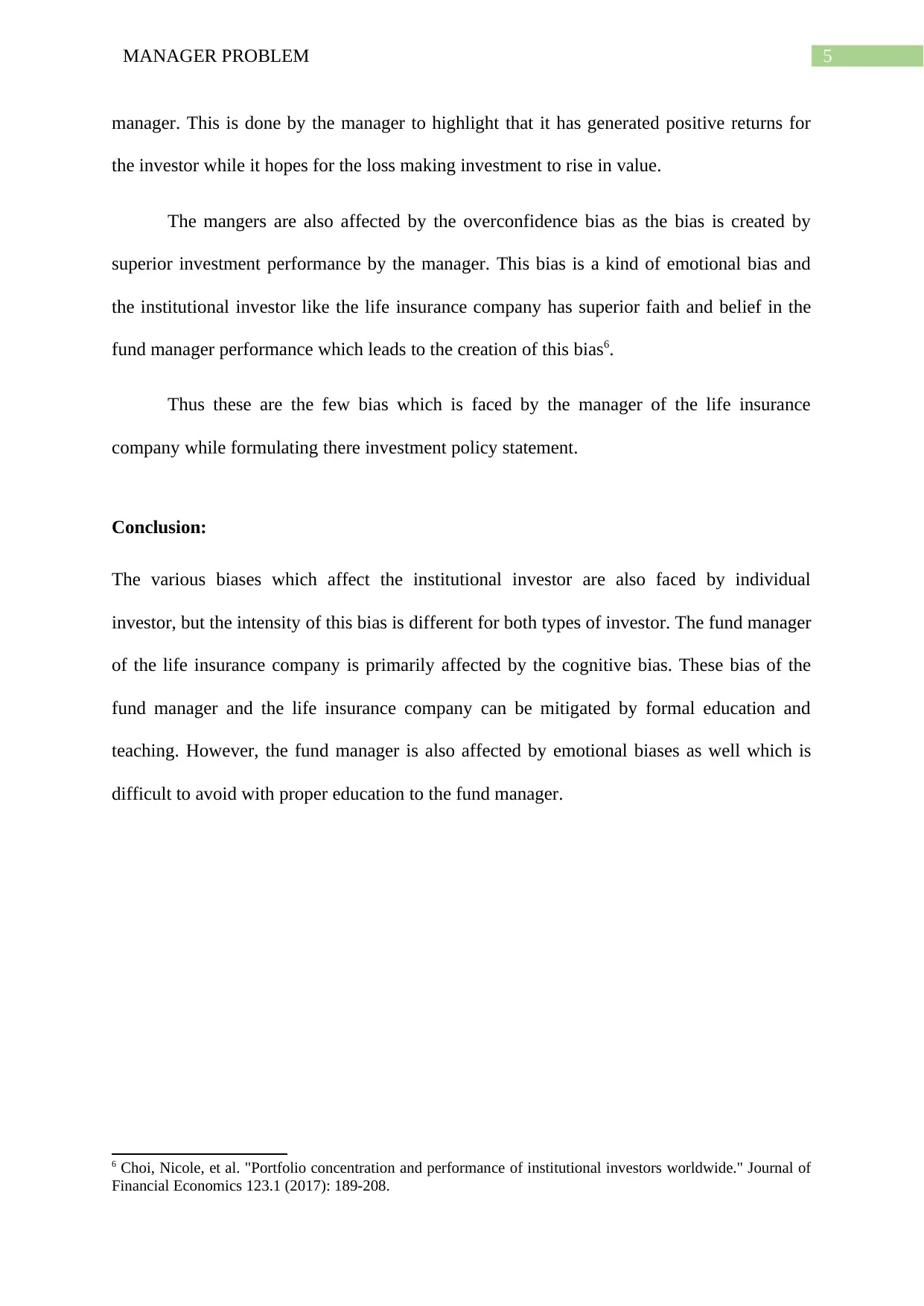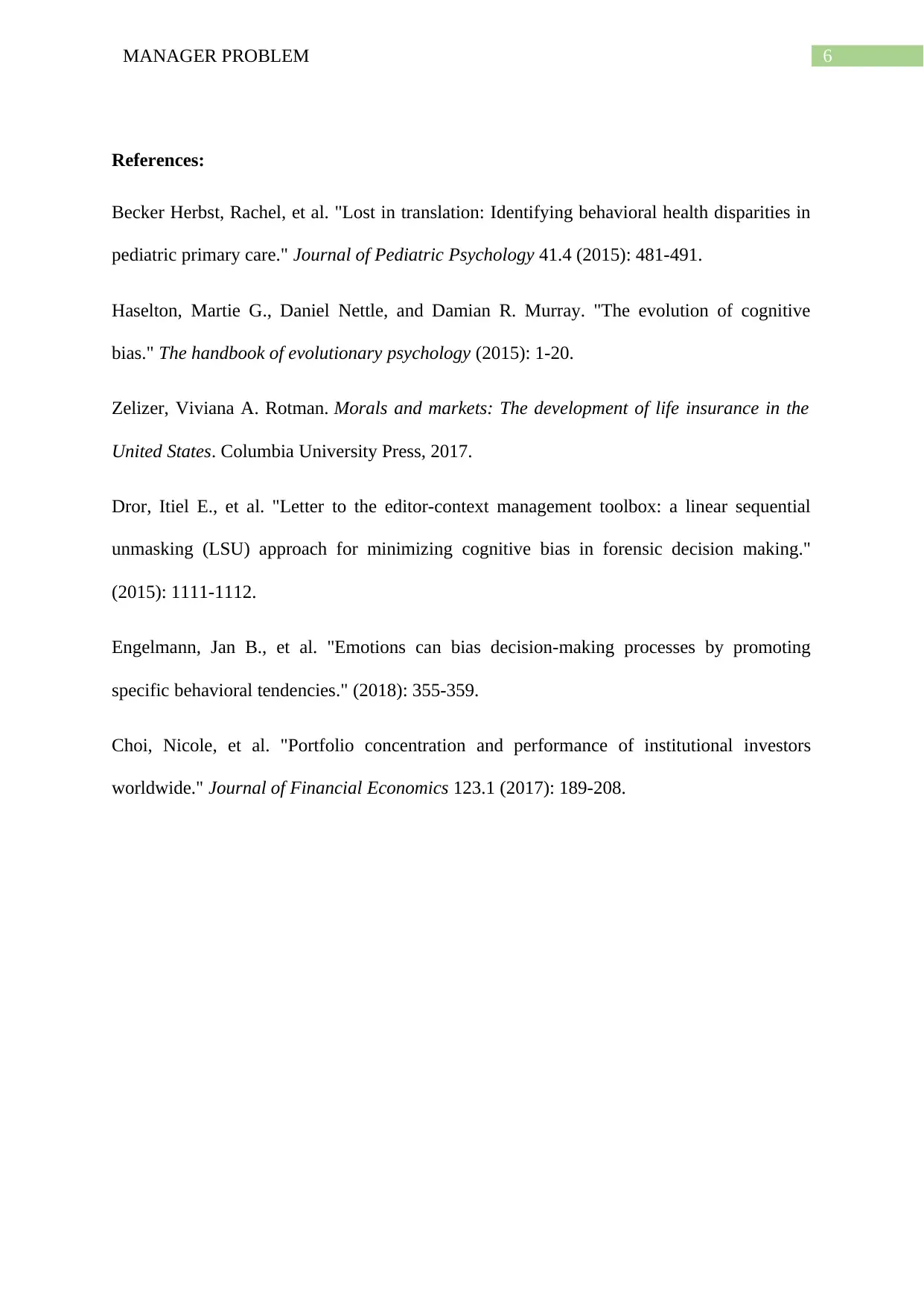Manager Problem: Behavioral Finance and Institutional Investors
VerifiedAdded on 2022/10/01
|6
|1064
|79
Discussion Board Post
AI Summary
This assignment explores the various biases that affect fund managers, particularly within institutional settings like life insurance companies, when formulating their investment policy statements. It distinguishes between cognitive and emotional biases, highlighting how cognitive biases can be mitigated through education, while emotional biases, stemming from past experiences or other factors, are more challenging to address. The analysis delves into specific biases such as short-termism, herding bias, loss aversion, home country bias, disposition effect, and overconfidence bias, illustrating how these biases influence investment decisions and portfolio management. The assignment emphasizes the importance of understanding these biases for effective institutional investment strategies and the challenges in managing them. The paper also mentions the biases that affect the institutional investor are also faced by individual investors, but the intensity of this bias is different for both types of investors.

Running head: MANAGER PROBLEM
Manager Problem
Name of the Student:
Name of the University:
Author Note:
Manager Problem
Name of the Student:
Name of the University:
Author Note:
Paraphrase This Document
Need a fresh take? Get an instant paraphrase of this document with our AI Paraphraser

2MANAGER PROBLEM
Table of Contents
Introduction:...............................................................................................................................3
Discussion:.............................................................................................................................3
Conclusion:................................................................................................................................5
References:.................................................................................................................................6
Table of Contents
Introduction:...............................................................................................................................3
Discussion:.............................................................................................................................3
Conclusion:................................................................................................................................5
References:.................................................................................................................................6

3MANAGER PROBLEM
Introduction:
The traditional finance highlights that the investors are rational and that the prices of
the securities in the market considers all the relevant information pertaining to that security.
The contradicting statement to this is provided by the behavioural finance theory where the
way the investors do not behave rationally because they are affected by several biases. The
biases can be cognitive or emotional. Thus in this report it is aimed to highlight the various
bias which is faced by the managers of fund managers while drafting the investment policy
statement1.
Discussion:
The biases which the investors have can be described as cognitive or emotional
biases. The fund manager of a life insurance company needs to incorporate this bias in the
investment policy statement of the individuals. The cognitive bias is a bias which is faced by
the investor, however this type of bias can be removed with the formal education of the
investor. Thus the manager of the fund can educate the investor to take more risk for a higher
return. Emotional bias are difficult to incorporate in the investment policy statement as the
bias is developed by some incidents of the past with the investor or due to some reason which
leads to development of this bias. This bias is difficult to remove and the manager has to
adapt the investment policy statement to incorporate the investor bias2.
The difficulties which is faced by the fund manager of the life insurance company is
that the insurance company need to meet a certain criteria for policy claims in the short term
and the long term. Thus this creates a liquidity constraint for the fund manager while
investing and thus the bias which is faced by the fund manager is Short-Termism. This bias
1 Haselton, Martie G., Daniel Nettle, and Damian R. Murray. "The evolution of cognitive bias." The handbook
of evolutionary psychology (2015): 1-20.
2 Becker Herbst, Rachel, et al. "Lost in translation: Identifying behavioral health disparities in pediatric primary
care." Journal of Pediatric Psychology 41.4 (2015): 481-491.
Introduction:
The traditional finance highlights that the investors are rational and that the prices of
the securities in the market considers all the relevant information pertaining to that security.
The contradicting statement to this is provided by the behavioural finance theory where the
way the investors do not behave rationally because they are affected by several biases. The
biases can be cognitive or emotional. Thus in this report it is aimed to highlight the various
bias which is faced by the managers of fund managers while drafting the investment policy
statement1.
Discussion:
The biases which the investors have can be described as cognitive or emotional
biases. The fund manager of a life insurance company needs to incorporate this bias in the
investment policy statement of the individuals. The cognitive bias is a bias which is faced by
the investor, however this type of bias can be removed with the formal education of the
investor. Thus the manager of the fund can educate the investor to take more risk for a higher
return. Emotional bias are difficult to incorporate in the investment policy statement as the
bias is developed by some incidents of the past with the investor or due to some reason which
leads to development of this bias. This bias is difficult to remove and the manager has to
adapt the investment policy statement to incorporate the investor bias2.
The difficulties which is faced by the fund manager of the life insurance company is
that the insurance company need to meet a certain criteria for policy claims in the short term
and the long term. Thus this creates a liquidity constraint for the fund manager while
investing and thus the bias which is faced by the fund manager is Short-Termism. This bias
1 Haselton, Martie G., Daniel Nettle, and Damian R. Murray. "The evolution of cognitive bias." The handbook
of evolutionary psychology (2015): 1-20.
2 Becker Herbst, Rachel, et al. "Lost in translation: Identifying behavioral health disparities in pediatric primary
care." Journal of Pediatric Psychology 41.4 (2015): 481-491.
⊘ This is a preview!⊘
Do you want full access?
Subscribe today to unlock all pages.

Trusted by 1+ million students worldwide

4MANAGER PROBLEM
highlights that the fund manager is more concerned with the short term return from the
investment, thus this is made at the cost of better long term prospects of the investment3.
The manager of the life insurance company also is affected by the herding bias, where
the manager tends to follow the investment protocols of other fund managers of the life
insurance company. This is because the managers need to achieve a minimum return required
by the insurance company to meet its liabilities and the statutory requirement. Hence the
manager refrain from making investment in an isolated environment. Thus the fund manager
makes investment with a herd mentality, so if the investment fails the entire industry would
be affected and thus the fund manager would be safe from criticism4.
Another bias faced by the manager of the life insurance company is the loss aversion
bias. This bias tends the manager to focus on avoiding losses which might occur due to
investment. Thus the manager is letting go of potential gains in the future by avoiding the
loss in the present. This bias is present in the managers on account of the loss of reputation of
the fund manager by the loss on investment5.
The fund manager also faces the home country bias as the life insurance company of
that country will want to have its fund to be invested in the home economy as it is considered
safe by the institutional investor. Thus the home country bias tends to make the fund manager
invest in the own country and forego the growth which might have been generated by
investing in the international securities.
Also the manager would also face the disposition effect bias which highlights that the
assets which have increased in value are sold and those which have decreased are kept by the
3 Zelizer, Viviana A. Rotman. Morals and markets: The development of life insurance in the United States.
Columbia University Press, 2017.
4 Dror, Itiel E., et al. "Letter to the editor-context management toolbox: a linear sequential unmasking (LSU)
approach for minimizing cognitive bias in forensic decision making." (2015): 1111-1112.
5 Engelmann, Jan B., et al. "Emotions can bias decision-making processes by promoting specific behavioral
tendencies." (2018): 355-359
highlights that the fund manager is more concerned with the short term return from the
investment, thus this is made at the cost of better long term prospects of the investment3.
The manager of the life insurance company also is affected by the herding bias, where
the manager tends to follow the investment protocols of other fund managers of the life
insurance company. This is because the managers need to achieve a minimum return required
by the insurance company to meet its liabilities and the statutory requirement. Hence the
manager refrain from making investment in an isolated environment. Thus the fund manager
makes investment with a herd mentality, so if the investment fails the entire industry would
be affected and thus the fund manager would be safe from criticism4.
Another bias faced by the manager of the life insurance company is the loss aversion
bias. This bias tends the manager to focus on avoiding losses which might occur due to
investment. Thus the manager is letting go of potential gains in the future by avoiding the
loss in the present. This bias is present in the managers on account of the loss of reputation of
the fund manager by the loss on investment5.
The fund manager also faces the home country bias as the life insurance company of
that country will want to have its fund to be invested in the home economy as it is considered
safe by the institutional investor. Thus the home country bias tends to make the fund manager
invest in the own country and forego the growth which might have been generated by
investing in the international securities.
Also the manager would also face the disposition effect bias which highlights that the
assets which have increased in value are sold and those which have decreased are kept by the
3 Zelizer, Viviana A. Rotman. Morals and markets: The development of life insurance in the United States.
Columbia University Press, 2017.
4 Dror, Itiel E., et al. "Letter to the editor-context management toolbox: a linear sequential unmasking (LSU)
approach for minimizing cognitive bias in forensic decision making." (2015): 1111-1112.
5 Engelmann, Jan B., et al. "Emotions can bias decision-making processes by promoting specific behavioral
tendencies." (2018): 355-359
Paraphrase This Document
Need a fresh take? Get an instant paraphrase of this document with our AI Paraphraser

5MANAGER PROBLEM
manager. This is done by the manager to highlight that it has generated positive returns for
the investor while it hopes for the loss making investment to rise in value.
The mangers are also affected by the overconfidence bias as the bias is created by
superior investment performance by the manager. This bias is a kind of emotional bias and
the institutional investor like the life insurance company has superior faith and belief in the
fund manager performance which leads to the creation of this bias6.
Thus these are the few bias which is faced by the manager of the life insurance
company while formulating there investment policy statement.
Conclusion:
The various biases which affect the institutional investor are also faced by individual
investor, but the intensity of this bias is different for both types of investor. The fund manager
of the life insurance company is primarily affected by the cognitive bias. These bias of the
fund manager and the life insurance company can be mitigated by formal education and
teaching. However, the fund manager is also affected by emotional biases as well which is
difficult to avoid with proper education to the fund manager.
6 Choi, Nicole, et al. "Portfolio concentration and performance of institutional investors worldwide." Journal of
Financial Economics 123.1 (2017): 189-208.
manager. This is done by the manager to highlight that it has generated positive returns for
the investor while it hopes for the loss making investment to rise in value.
The mangers are also affected by the overconfidence bias as the bias is created by
superior investment performance by the manager. This bias is a kind of emotional bias and
the institutional investor like the life insurance company has superior faith and belief in the
fund manager performance which leads to the creation of this bias6.
Thus these are the few bias which is faced by the manager of the life insurance
company while formulating there investment policy statement.
Conclusion:
The various biases which affect the institutional investor are also faced by individual
investor, but the intensity of this bias is different for both types of investor. The fund manager
of the life insurance company is primarily affected by the cognitive bias. These bias of the
fund manager and the life insurance company can be mitigated by formal education and
teaching. However, the fund manager is also affected by emotional biases as well which is
difficult to avoid with proper education to the fund manager.
6 Choi, Nicole, et al. "Portfolio concentration and performance of institutional investors worldwide." Journal of
Financial Economics 123.1 (2017): 189-208.

6MANAGER PROBLEM
References:
Becker Herbst, Rachel, et al. "Lost in translation: Identifying behavioral health disparities in
pediatric primary care." Journal of Pediatric Psychology 41.4 (2015): 481-491.
Haselton, Martie G., Daniel Nettle, and Damian R. Murray. "The evolution of cognitive
bias." The handbook of evolutionary psychology (2015): 1-20.
Zelizer, Viviana A. Rotman. Morals and markets: The development of life insurance in the
United States. Columbia University Press, 2017.
Dror, Itiel E., et al. "Letter to the editor-context management toolbox: a linear sequential
unmasking (LSU) approach for minimizing cognitive bias in forensic decision making."
(2015): 1111-1112.
Engelmann, Jan B., et al. "Emotions can bias decision-making processes by promoting
specific behavioral tendencies." (2018): 355-359.
Choi, Nicole, et al. "Portfolio concentration and performance of institutional investors
worldwide." Journal of Financial Economics 123.1 (2017): 189-208.
References:
Becker Herbst, Rachel, et al. "Lost in translation: Identifying behavioral health disparities in
pediatric primary care." Journal of Pediatric Psychology 41.4 (2015): 481-491.
Haselton, Martie G., Daniel Nettle, and Damian R. Murray. "The evolution of cognitive
bias." The handbook of evolutionary psychology (2015): 1-20.
Zelizer, Viviana A. Rotman. Morals and markets: The development of life insurance in the
United States. Columbia University Press, 2017.
Dror, Itiel E., et al. "Letter to the editor-context management toolbox: a linear sequential
unmasking (LSU) approach for minimizing cognitive bias in forensic decision making."
(2015): 1111-1112.
Engelmann, Jan B., et al. "Emotions can bias decision-making processes by promoting
specific behavioral tendencies." (2018): 355-359.
Choi, Nicole, et al. "Portfolio concentration and performance of institutional investors
worldwide." Journal of Financial Economics 123.1 (2017): 189-208.
⊘ This is a preview!⊘
Do you want full access?
Subscribe today to unlock all pages.

Trusted by 1+ million students worldwide
1 out of 6
Related Documents
Your All-in-One AI-Powered Toolkit for Academic Success.
+13062052269
info@desklib.com
Available 24*7 on WhatsApp / Email
![[object Object]](/_next/static/media/star-bottom.7253800d.svg)
Unlock your academic potential
Copyright © 2020–2025 A2Z Services. All Rights Reserved. Developed and managed by ZUCOL.





